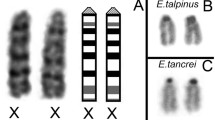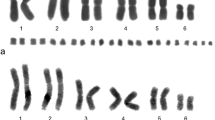Abstract
Mitotic and meiotic analysis with light and electron microscopy was performed in male and female zebra finches (Taeniopygia guttata). Somatic cells from bone marrow have a 2n = 80 and show the usual sex chromosome mechanism of birds ZZ (male)/ZW (female). In the germ lines of both sexes, a single accessory chromosome was regularly present in all the cells examined from all the individual birds. In synaptonemal complex (SC) spreads of pachytene oocytes and spermatocytes, this accessory chromosome forms a single axis, but it behaves differentially in male and female meiosis. While this accessory chromosome is euchromatic in oocytes, it is strongly heterochromatic in spermatocytes. In pachytene spermatocytes, the accessory chromosome adopts a morphology strikingly similar to that of the XY body (‘sex vesicle’) of mammalian spermatocytes. This accessory chromosome is eliminated during male meiosis and forms a cytoplasmic dense body in young spermatids that shows strong fluorescence with DAPI. The presence of this germ line-restricted chromosome does not affect the behaviour of the ZW pair in oocytes, as the sex chromosomes pair regularly and show a localized recombination nodule. It is suggested that this accessory chromosome has transcriptional activity during oogenesis, and thus it is regularly transmitted through preferential segregation during female meiosis.
Similar content being viewed by others
References
Capanna E, Civitelli MV, Martinico E (1987) I cromosomi degli uccelli, citotassonomia ed evoluzione cariotipica. Avocetta 11: 101–143.
Cooper A, Penny D (1997) Mass survival of birds across the cretaceous—tertiary boundary: molecular evidence. Science 275: 1109–1112.
De Boer LEM (1984) New developments in vertebrate cytotaxonomy. VIII. A current list of references on avian karyology. Genetica 65: 3–37.
Evans EP, Breckon G, Ford CE (1964) An air-drying method for meiotic preparations from mammalian testes. Cytogenetics 3: 289–294.
Howell WM, Black DA (1980) Controlled silver staining of nucleolus organizing regions with a protective coloidal developer: a 1-step method. Experientia 36: 1014–1015.
Ishak B, Jafaar H, Maetz JL, Rumpler Y (1991) Absence of transcriptional activity of B-chromosomes of Apodemus peninsulae during pachytene. Chromosoma 100: 278–281.
Jones RN, Rees H (1982) B-chromosomes. London: Academic Press.
Kaelbling M, Fechheimer NS (1983) Synaptonemal complexes and the chromosome complement of the domestic fowl, Gallus domesticus. Cytogenet Cell Genet 35: 87–92.
Moses MJ (1977) Synaptonemal complex karyotyping in spermatocytes of the Chinese hamster (Cricetulus griseus). I. Morphology of the autosomal complement in spread preparations. Chromosoma 60: 99–125.
Moses MJ, Poorman PA, Roderick TH, Davisson MT (1982) Synaptonemal complex analysis of mouse chromosomal rearrangements. IV. Synapsis and synaptic adjustment in two paracentric inversions. Chromosoma 84: 454–474.
Ogawa A, Solovei I, Hutchison N, Saitoh Y, Ikeda J, Macgregor H, Mizuno S (1997) Molecular characterization and cytological mapping of a non-repetitive DNA sequence region from the W chromosome of chicken and its use as a universal probe for sexing Carinatae birds. Chrom Res 5: 93–101.
Peters A, Plug A, van Vugt M, de Boer P (1997) A drying-down technique for the spreading of mammalian meiocytes from the male and female germline. Chrom Res 5: 66–71.
Pollock DL, Fechheimer NS (1978) The chromosomes of cockerels during meiosis. Cytogenet Cell Genet 21: 267–281.
Rahn MI, Solari AJ (1986) Recombination nodules in the oocytes of the chicken, Gallus domesticus. Cytogenet Cell Genet 43: 187–193.
Sibley CG, Ahlquist JE (1990) Phylogeny and Classification of Birds. A Study in Molecular Evolution. Yale University Press. New Haven.
Solari AJ (1974) The behavior of the XY pair in mammals. Int Rev Cytol 38: 273–317.
Solari AJ (1977) Ultrastructure of the synaptic autosomes and the ZW bivalent in chicken oocytes. Chromosoma 64: 155–165.
Solari AJ, Fechheimer NS, Bitgood JJ (1988) Pairing of ZW gonosomes and the localized recombination nodule in two Z-autosome translocations in Gallus domesticus. Cytogenet Cell Genet 48: 130–136.
Solari AJ (1989) Sex chromosome pairing and fertility in the heterogametic sex of mammals and birds. In: Gillies CB, ed. Fertility and Chromosome Pairing: Recent Studies in Plants and Animals. Boca Raton: CRC Press, pp 78–107.
Solari AJ (1993) Sex Chromosomes and Sex Determination in Vertebrates. CRC Press: Boca Raton.
Solari AJ, Pigozzi MI (1993) Recombination nodules and axial equalization in the ZW pairs of the Peking duck and the Guinea fowl. Cytogenet Cell Genet 64: 268–272.
Solovei I, Gaginskaya E, Hutchison N, Macgregor H (1993) Avian sex chromosomes in the lampbrush form: the ZW lampbrush bivalents from six species of birds. Chrom Res 1: 153–166.
Switonski M, Gustavsson I, Höjer K, Plöen L (1987) Synaptonemal complex analysis of the B-chromosomes in spermatocytes of the silver fox (Vulpes vulpes Desm.). Cytogenet Cell Genet 45: 84–92.
Tiersch TR, Wachtel SS (1991) On the evolution of genome size in birds. J Hered 82: 363–368.
von Wettstein D, Rasmussen SW, Holm PB (1984) The synaptonemal complex in genetic segregation. Annu Rev Genet 18: 331–413.
Author information
Authors and Affiliations
Rights and permissions
About this article
Cite this article
Pigozzi, M.I., Solari, A.J. Germ cell restriction and regular transmission of an accessory chromosome that mimics a sex body in the zebra finch, Taeniopygia guttata. Chromosome Res 6, 105–113 (1998). https://doi.org/10.1023/A:1009234912307
Issue Date:
DOI: https://doi.org/10.1023/A:1009234912307




